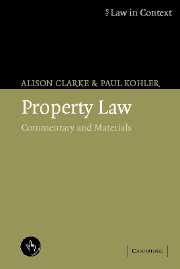Book contents
- Frontmatter
- Contents
- Preface
- Acknowledgments
- Table of cases
- Table of statutes
- Table of statutory instruments
- Table of treaties
- Table of EC legislation
- Part 1 The concept of property
- Part 2 The nature of proprietary interests
- Part 3 The acquisition and disposition of property interests
- 10 Title
- 11 Acquiring title by possession
- 12 Transfer and grant
- 13 Acquiring interests by other methods
- 14 Enforceability and priority of interests
- 15 Registration
- Part 4 Proprietary relationships
- Bibliography
- Index
12 - Transfer and grant
Published online by Cambridge University Press: 05 June 2012
- Frontmatter
- Contents
- Preface
- Acknowledgments
- Table of cases
- Table of statutes
- Table of statutory instruments
- Table of treaties
- Table of EC legislation
- Part 1 The concept of property
- Part 2 The nature of proprietary interests
- Part 3 The acquisition and disposition of property interests
- 10 Title
- 11 Acquiring title by possession
- 12 Transfer and grant
- 13 Acquiring interests by other methods
- 14 Enforceability and priority of interests
- 15 Registration
- Part 4 Proprietary relationships
- Bibliography
- Index
Summary
Derivative acquisition
In Chapter 11, we looked at the way property interests are acquired by original acquisition, in particular by taking possession of things. In this chapter, we look at the derivative acquisition of property interests, through transfer of interests and through the grant of subsidiary property interests. In most cases, a property interest passes from one person to another, or is carved out of a larger property interest, because the parties intend this to happen and deliberately take steps to achieve it. The transaction may be a gift from one to the other or it may be part of a bargain, with value provided in exchange. We are mostly concerned in this chapter with straightforward intentional dispositions like these.
There are two principal issues is this chapter. The first concerns the way in which property interests pass from one person to another. This is essentially a matter of formalities – the formal requirements that the law imposes for a property interest to pass from one person to another. We look at this in sections 12.2 and 12.3 below. Section 12.2 covers general principles about formalities rules, why we have such rules and what the rules are. Section 12.3 highlights one particular and complex area, which is how and when equitable property rights arise out of contracts to acquire property rights in the future, and out of attempted legal transactions which fail because of a failure to comply with formalities rules.
- Type
- Chapter
- Information
- Property LawCommentary and Materials, pp. 448 - 488Publisher: Cambridge University PressPrint publication year: 2005



